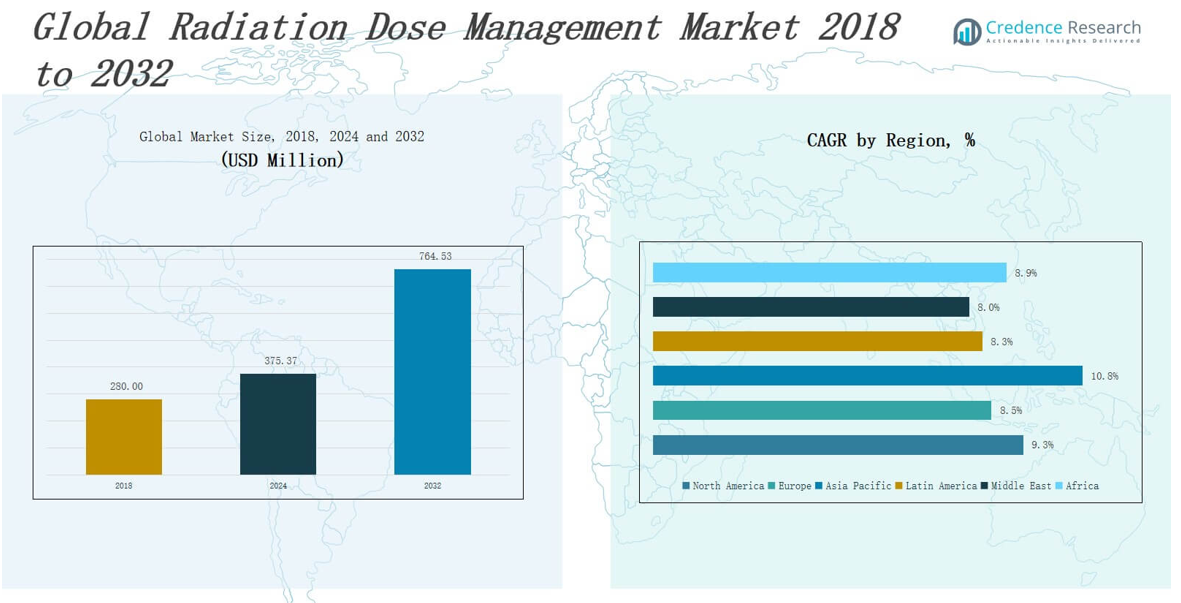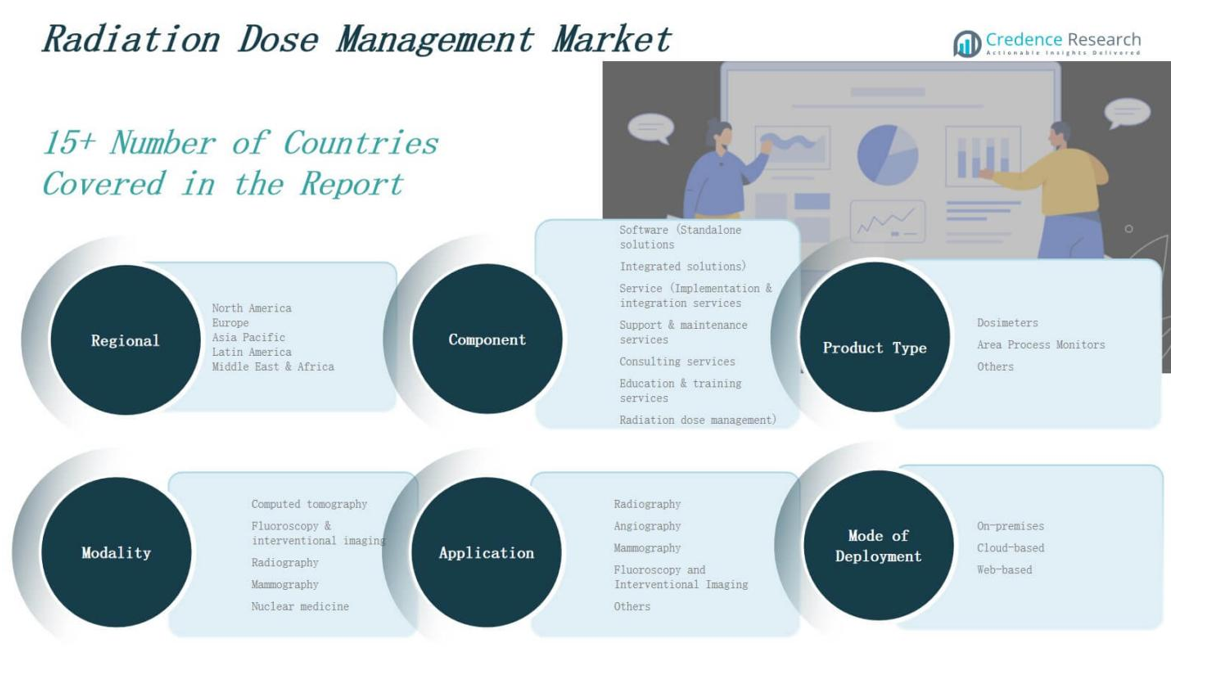CHAPTER NO. 1 : GENESIS OF THE MARKET
1.1 Market Prelude – Introduction & Scope
1.2 The Big Picture – Objectives & Vision
1.3 Strategic Edge – Unique Value Proposition
1.4 Stakeholder Compass – Key Beneficiaries
CHAPTER NO. 2 : EXECUTIVE LENS
2.1 Pulse of the Industry – Market Snapshot
2.2 Growth Arc – Revenue Projections (USD Million)
2.3. Premium Insights – Based on Primary Interviews
CHAPTER NO. 3 : RADIATION DOSE MANAGEMENT MARKET FORCES & INDUSTRY PULSE
3.1 Foundations of Change – Market Overview
3.2 Catalysts of Expansion – Key Market Drivers
3.2.1 Momentum Boosters – Growth Triggers
3.2.2 Innovation Fuel – Disruptive Technologies
3.3 Headwinds & Crosswinds – Market Restraints
3.3.1 Regulatory Tides – Compliance Challenges
3.3.2 Economic Frictions – Inflationary Pressures
3.4 Untapped Horizons – Growth Potential & Opportunities
3.5 Strategic Navigation – Industry Frameworks
3.5.1 Market Equilibrium – Porter’s Five Forces
3.5.2 Ecosystem Dynamics – Value Chain Analysis
3.5.3 Macro Forces – PESTEL Breakdown
3.6 Price Trend Analysis
3.6.1 Regional Price Trend
3.6.2 Price Trend by product
CHAPTER NO. 4 : KEY INVESTMENT EPICENTER
4.1 Regional Goldmines – High-Growth Geographies
4.2 Modality Frontiers – Lucrative Modality Categories
4.3 Type Sweet Spots – Emerging Demand Segments
CHAPTER NO. 5: REVENUE TRAJECTORY & WEALTH MAPPING
5.1 Momentum Metrics – Forecast & Growth Curves
5.2 Regional Revenue Footprint – Market Share Insights
5.3 Segmental Wealth Flow – Component & Type Revenue
CHAPTER NO. 6 : TRADE & COMMERCE ANALYSIS
6.1. Import Analysis by Region
6.1.1. Global Radiation Dose Management Market Import Revenue By Region
6.2. Export Analysis by Region
6.2.1. Global Radiation Dose Management Market Export Revenue By Region
CHAPTER NO. 7 : COMPETITION ANALYSIS
7.1. Company Market Share Analysis
7.1.1. Global Radiation Dose Management Market: Company Market Share
7.2. Global Radiation Dose Management Market Company Revenue Market Share
7.3. Strategic Developments
7.3.1. Acquisitions & Mergers
7.3.2. New Modality Launch
7.3.3. Regional Expansion
7.4. Competitive Dashboard
7.5. Company Assessment Metrics, 2024
CHAPTER NO. 8 : RADIATION DOSE MANAGEMENT MARKET – BY COMPONENT SEGMENT ANALYSIS
8.1. Radiation Dose Management Market Overview by Component Segment
8.1.1. Radiation Dose Management Market Revenue Share By Component
8.2. Software
8.2.1 Standalone solutions
8.2.2 Integrated solutions
8.4. Service
8.4.1 Implementation & Integration Services
8.4.2 Support & Maintenance Services
8.4.3 Consulting Services
8.4.4 Education & Training Services
CHAPTER NO. 9 : RADIATION DOSE MANAGEMENT MARKET – BY PRODUCT TYPE SEGMENT ANALYSIS
9.1. Radiation Dose Management Market Overview by Product Type Segment
9.1.1. Radiation Dose Management Market Revenue Share By Product Type
9.2. Dosimeters
9.3. Area Process Monitors
9.4. Others
CHAPTER NO. 10 : RADIATION DOSE MANAGEMENT MARKET – BY MODALITY SEGMENT ANALYSIS
10.1. Radiation Dose Management Market Overview by Modality Segment
10.1.1. Radiation Dose Management Market Revenue Share By Modality
10.2. Computed Tomography
10.3. Fluoroscopy & Interventional Imaging
10.4. Radiography
10.5. Mammography
10.6. Nuclear Medicine
CHAPTER NO. 11 : RADIATION DOSE MANAGEMENT MARKET – BY APPLICATION SEGMENT ANALYSIS
11.1. Radiation Dose Management Market Overview by Application Segment
11.1.1. Radiation Dose Management Market Revenue Share By Application
11.2. Radiography
11.3. Angiography
11.4. Mammography
11.5. Fluoroscopy and Interventional Imaging
11.6. Others
CHAPTER NO. 12 : RADIATION DOSE MANAGEMENT MARKET – BY MODE OF DEPLOYMENT SEGMENT ANALYSIS
12.1. Radiation Dose Management Market Overview by Mode of Deployment Segment
12.1.1. Radiation Dose Management Market Revenue Share By Mode of Deployment
12.2. On-premises
12.3. Cloud-based
12.4. Web-based
CHAPTER NO. 13 : RADIATION DOSE MANAGEMENT MARKET – REGIONAL ANALYSIS
13.1. Radiation Dose Management Market Overview by Region Segment
13.1.1. Global Radiation Dose Management Market Revenue Share By Region
13.1.2. Regions
13.1.3. Global Radiation Dose Management Market Revenue By Region
13.1.4. Service Product Type
13.1.5. Global Radiation Dose Management Market Revenue By Service Product Type
13.1.6. Product Type
13.1.7. Global Radiation Dose Management Market Revenue By Product Type
13.1.8. Modality
13.1.9. Global Radiation Dose Management Market Revenue By Modality
13.1.10. Application
13.1.12. Global Radiation Dose Management Market Revenue By Application
13.1.13. Mode of Deployment
13.1.14. Global Radiation Dose Management Market Revenue By Mode of Deployment
CHAPTER NO. 14 : NORTH AMERICA RADIATION DOSE MANAGEMENT MARKET – COUNTRY ANALYSIS
14.1. North America Radiation Dose Management Market Overview by Country Segment
14.1.1. North America Radiation Dose Management Market Revenue Share By Region
14.2. North America
14.2.1. North America Radiation Dose Management Market Revenue By Country
14.2.2. Service Product Type
14.2.3. North America Radiation Dose Management Market Revenue By Service Product Type
14.2.4. Product Type
14.2.5. North America Radiation Dose Management Market Revenue By Product Type
14.2.6. Modality
14.2.7. North America Radiation Dose Management Market Revenue By Modality
14.2.8. Application
14.2.9. North America Radiation Dose Management Market Revenue By Application
14.2.10. Mode of Deployment
14.2.11. North America Radiation Dose Management Market Revenue By Mode of Deployment
14.3. U.S.
14.4. Canada
14.5. Mexico
CHAPTER NO. 15 : EUROPE RADIATION DOSE MANAGEMENT MARKET – COUNTRY ANALYSIS
15.1. Europe Radiation Dose Management Market Overview by Country Segment
15.1.1. Europe Radiation Dose Management Market Revenue Share By Region
15.2. Europe
15.2.1. Europe Radiation Dose Management Market Revenue By Country
15.2.2. Service Product Type
15.2.3. Europe Radiation Dose Management Market Revenue By Service Product Type
15.2.4. Product Type
15.2.5. Europe Radiation Dose Management Market Revenue By Product Type
15.2.6. Modality
15.2.7. Europe Radiation Dose Management Market Revenue By Modality
15.2.8. Application
15.2.9. Europe Radiation Dose Management Market Revenue By Application
15.2.10. Mode of Deployment
15.2.11. Europe Radiation Dose Management Market Revenue By Mode of Deployment
15.3. UK
15.4. France
15.5. Germany
15.6. Italy
15.7. Spain
15.8. Russia
15.9. Rest of Europe
CHAPTER NO. 16 : ASIA PACIFIC RADIATION DOSE MANAGEMENT MARKET – COUNTRY ANALYSIS
16.1. Asia Pacific Radiation Dose Management Market Overview by Country Segment
16.1.1. Asia Pacific Radiation Dose Management Market Revenue Share By Region
16.2. Asia Pacific
16.2.1. Asia Pacific Radiation Dose Management Market Revenue By Country
16.2.2. Service Product Type
16.2.3. Asia Pacific Radiation Dose Management Market Revenue By Service Product Type
16.2.4. Product Type
16.2.5. Asia Pacific Radiation Dose Management Market Revenue By Product Type
16.2.6. Modality
16.2.7. Asia Pacific Radiation Dose Management Market Revenue By Modality
16.2.8. Application
16.2.9. Asia Pacific Radiation Dose Management Market Revenue By Application
16.2.10. Mode of Deployment
16.2.11. Asia Pacific Radiation Dose Management Market Revenue By Mode of Deployment
16.3. China
16.4. Japan
16.5. South Korea
16.6. India
16.7. Australia
16.8. Southeast Asia
16.9. Rest of Asia Pacific
CHAPTER NO. 17 : LATIN AMERICA RADIATION DOSE MANAGEMENT MARKET – COUNTRY ANALYSIS
17.1. Latin America Radiation Dose Management Market Overview by Country Segment
17.1.1. Latin America Radiation Dose Management Market Revenue Share By Region
17.2. Latin America
17.2.1. Latin America Radiation Dose Management Market Revenue By Country
17.2.2. Service Product Type
17.2.3. Latin America Radiation Dose Management Market Revenue By Service Product Type
17.2.4. Product Type
17.2.5. Latin America Radiation Dose Management Market Revenue By Product Type
17.2.6. Modality
17.2.7. Latin America Radiation Dose Management Market Revenue By Modality
17.2.8. Application
17.2.9. Latin America Radiation Dose Management Market Revenue By Application
17.2.10. Mode of Deployment
17.2.11. Latin America Radiation Dose Management Market Revenue By Mode of Deployment
17.3. Brazil
17.4. Argentina
17.5. Rest of Latin America
CHAPTER NO. 18 : MIDDLE EAST RADIATION DOSE MANAGEMENT MARKET – COUNTRY ANALYSIS
18.1. Middle East Radiation Dose Management Market Overview by Country Segment
18.1.1. Middle East Radiation Dose Management Market Revenue Share By Region
18.2. Middle East
18.2.1. Middle East Radiation Dose Management Market Revenue By Country
18.2.2. Service Product Type
18.2.3. Middle East Radiation Dose Management Market Revenue By Service Product Type
18.2.4. Product Type
18.2.5. Middle East Radiation Dose Management Market Revenue By Product Type
18.2.6. Modality
18.2.7. Middle East Radiation Dose Management Market Revenue By Modality
18.2.8. Application
18.2.9. Middle East Radiation Dose Management Market Revenue By Application
18.2.10. Mode of Deployment
18.2.11. Middle East Radiation Dose Management Market Revenue By Mode of Deployment
18.3. GCC Countries
18.4. Israel
18.5. Turkey
18.6. Rest of Middle East
CHAPTER NO. 19 : AFRICA RADIATION DOSE MANAGEMENT MARKET – COUNTRY ANALYSIS
19.1. Africa Radiation Dose Management Market Overview by Country Segment
19.1.1. Africa Radiation Dose Management Market Revenue Share By Region
19.2. Africa
19.2.1. Africa Radiation Dose Management Market Revenue By Country
19.2.2. Service Product Type
19.2.3. Africa Radiation Dose Management Market Revenue By Service Product Type
19.2.4. Product Type
19.2.5. Africa Radiation Dose Management Market Revenue By Product Type
19.2.6. Modality
19.2.7. Africa Radiation Dose Management Market Revenue By Modality
19.2.8. Application
19.2.9. Africa Radiation Dose Management Market Revenue By Application
19.2.10. Mode of Deployment
19.2.11. Africa Radiation Dose Management Market Revenue By Mode of Deployment
19.3. South Africa
19.4. Egypt
19.5. Rest of Africa
CHAPTER NO. 20 : COMPANY PROFILES
20.1. Bayer AG
20.1.1. Company Overview
20.1.2. Modality Portfolio
20.1.3. Financial Overview
20.1.4. Recent Developments
20.1.5. Growth Strategy
20.1.6. SWOT Analysis
20.2. Sectra AB (Sweden)
20.3. GE HealthCare (USA)
20.4. Philips Healthcare (Netherlands)
20.5. Siemens Healthineers (Germany)
20.6. Fujifilm Holdings Corporation (Japan)
20.7. Canon Medical Systems Corporation (Japan)
20.8. Bracco Imaging S.p.A. (Italy)
20.9. PACSHealth LLC (USA)
20.10. Qaelum NV (Belgium)
20.11. Radimetrics Inc. (Canada)
20.12. Agfa-Gevaert Group (Belgium)
20.13. MedicVision Imaging Solutions Ltd. (Israel)
20.14. Infinitt Healthcare (South Korea)
20.15. Novarad Corporation (USA)
20.16. Imalogix, LLC (USA)
20.17. L3Harris Technologies (USA)
20.18. Thermo Fisher Scientific (USA)
20.19. Lumen Technologies, Inc. (United States)









